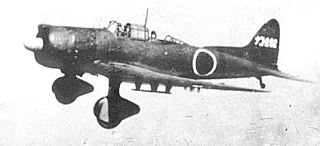
Aichi Kokuki KK was a Japanese aircraft manufacturer which produced several designs for the Imperial Japanese Navy. After the war, the company was reorganized as Aichi Machine Industry Co., Ltd (愛知機械工業) where they made small kei cars until 1966 when they were integrated into Nissan and developed the Nissan Sunny and Nissan Vanette.

A triplane is a fixed-wing aircraft equipped with three vertically stacked wing planes. Tailplanes and canard foreplanes are not normally included in this count, although they occasionally are.
A scout plane is type of surveillance aircraft, usually of single-engined, two/three seats, shipborne type, and used for the purpose of discovering an enemy position and directing artillery. Therefore, a scout plane is essentially a small naval aircraft, as distinguished from a tactical ground observation aircraft, a strategic reconnaissance "spyplane", or a large patrol flying boat.

Observation seaplanes are military aircraft with flotation devices allowing them to land on and take off from water. Their primary purpose was to observe and report enemy movements or to spot the fall of shot from naval artillery, but some were armed with machineguns or bombs. Their military usefulness extended from World War I through World War II. They were typically single-engine machines with catapult-launch capability and a crew of one, two or three. Most were designed to be carried aboard warships, but they also operated from seashore harbors.